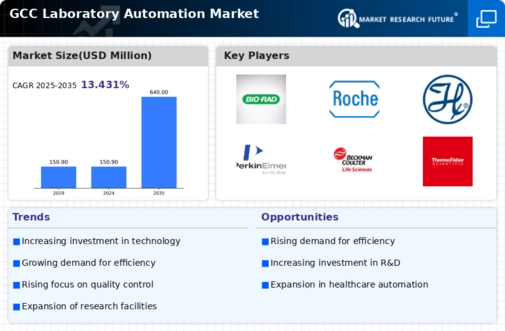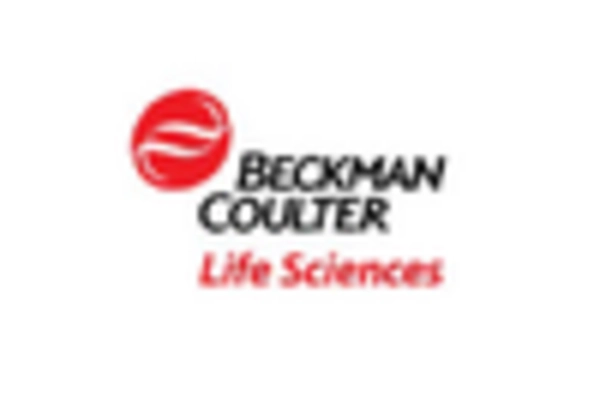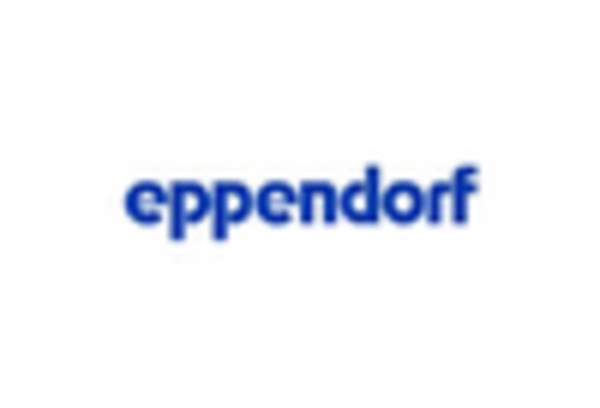Growing Emphasis on Quality Control
Quality control remains a pivotal aspect of laboratory operations, significantly influencing the laboratory automation market. In the GCC, regulatory bodies are enforcing stricter quality standards across various industries, including healthcare and pharmaceuticals. This regulatory landscape is driving laboratories to adopt automated solutions that ensure compliance and enhance the accuracy of results. The market for quality control automation is expected to expand by approximately 10% in the coming years, as laboratories seek to minimize errors and improve reliability. Automation technologies facilitate real-time monitoring and data collection, allowing for immediate corrective actions when deviations occur. Thus, the growing emphasis on quality control is likely to propel the laboratory automation market forward, as organizations prioritize precision and adherence to regulatory requirements.
Focus on Cost Reduction and Efficiency
Cost reduction and operational efficiency are paramount concerns for laboratories, driving the laboratory automation market towards innovative solutions. In the GCC, laboratories are increasingly adopting automation technologies to streamline processes and reduce operational costs. The market is projected to grow by around 9% as organizations seek to optimize resource allocation and minimize waste. Automation not only enhances productivity but also allows for better utilization of laboratory space and personnel. By automating repetitive tasks, laboratories can redirect human resources towards more complex and value-added activities. This focus on cost reduction and efficiency is likely to shape the future of the laboratory automation market, as organizations strive to achieve sustainable growth while maintaining high standards of quality and performance.
Advancements in Artificial Intelligence
Artificial intelligence (AI) is emerging as a transformative force within the laboratory automation market. The integration of AI technologies into laboratory processes enhances data analysis, predictive modeling, and decision-making capabilities. In the GCC, investments in AI-driven automation solutions are on the rise, with a projected market growth of around 15% annually. This advancement allows laboratories to streamline operations, reduce human error, and improve overall efficiency. AI algorithms can analyze vast datasets, providing insights that were previously unattainable. As laboratories increasingly adopt AI technologies, the laboratory automation market is likely to witness a paradigm shift, enabling more sophisticated and intelligent automation solutions that cater to the specific needs of researchers and scientists.
Rising Demand for High-Throughput Screening
The laboratory automation market is experiencing a notable increase in demand for high-throughput screening solutions. This trend is driven by the need for rapid and efficient testing in various sectors, including pharmaceuticals and biotechnology. In the GCC region, the market for high-throughput screening is projected to grow at a CAGR of approximately 12% over the next five years. This growth is attributed to the increasing focus on drug discovery and development, where automation plays a crucial role in enhancing productivity and accuracy. As laboratories seek to optimize their workflows, the integration of automated systems for high-throughput screening is becoming essential. Consequently, this driver is likely to shape the future landscape of the laboratory automation market, as organizations strive to meet the escalating demands for faster and more reliable testing processes.
Increased Investment in Research and Development
Investment in research and development (R&D) is a critical driver of growth in the laboratory automation market. The GCC region is witnessing a surge in funding for R&D initiatives, particularly in the fields of life sciences and biotechnology. This trend is expected to result in a market growth rate of approximately 11% over the next few years. As organizations allocate more resources to R&D, the demand for advanced laboratory automation solutions is likely to rise. Automation technologies enable researchers to conduct experiments more efficiently, thereby accelerating the pace of innovation. Furthermore, the integration of automated systems in R&D laboratories enhances reproducibility and data integrity, which are essential for successful research outcomes. Consequently, increased investment in R&D is poised to significantly impact the laboratory automation market, fostering advancements and breakthroughs in various scientific domains.

















Leave a Comment